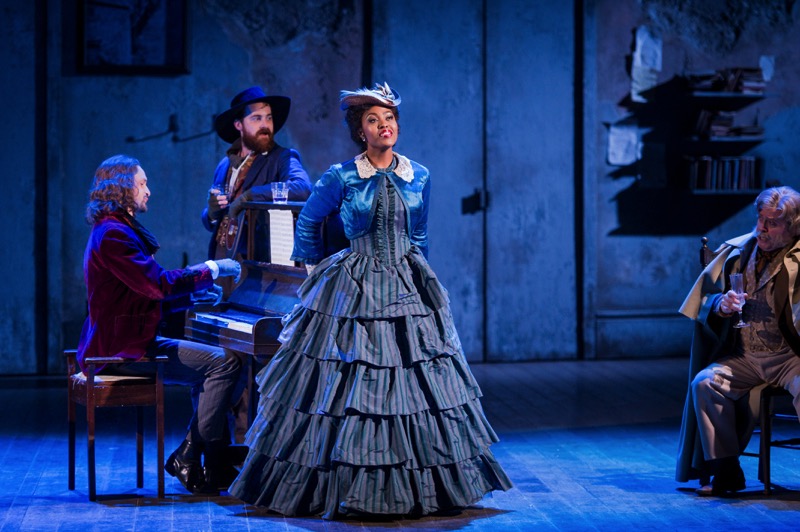La Bohème, Grange Park Opera, GPO, June 2015
Posted on 20 June 2015There seem to have been a plethora of Bohèmes recently. The one by English Touring Opera last autumn shows a performance can tug unbearably on the heart-strings accompanied by only the simplest of sets, and the final run of John Copley’s Covent Garden production shows that even with the most glorious sets and world’s top singers, perfection is beyond reach if your Musetta is over the top.

Bohemians entertain their landlord, all images GPO/ Robert Workman
No such problem here with Kelebogile Besong, whose performance of that role combined admirable coquettishness with delightful vocal histrionics in Act II, and the incident with the shoe was one of the best I’ve seen. The production, however, was unusual — neither elaborate nor minimal — but director Stephen Medcalf has treated the whole thing as four young men putting on a play.

Mimi and Rodolfo — off to Café Momus
At the start they take costumes out of a large chest, and in the final moments replace them. The side and rear doors to the stage have chalk marks on the back indicating their relationship to the make-believe world inside, and this deliberately amateurish pretence might explain why Mimi does a wonderful stage faint when she enters in Act I, and Rodolfo emotes too much in Act IV. At the end, rather than go to her side he is comforted by his three companions, before all four of them doff top hats and exit stage rear silhouetted in the narrow doorways. Four young gentlemen at play, it seems, but with some excellent singing.

Musetta at the café, Schaunard tinkles the ivories
Rodolfo’s companions all gave fine vocal and dramatic portrayals: Quirijn de Lang as a wonderfully stylish Schaunard, Nicholas Crawley terrific in the coat song as Colline, and Brett Polegato strongly voiced as a hugely engaging and sympathetic Marcello, interacting beautifully with Kelebogile’s well-nuanced and very attractive Musetta. As Rodolfo, Gianluca Terranova’s brandishing of his strong Italianate tenor was somewhat uneven, but Susana Gaspar delivered a fine mix of warmth, frailty and poetic yearning as Mimi. She and the rest of the cast were underpinned in some style by the conducting of Stephen Barlow, who gave the music its rightful Italian warmth and dynamics.

Farewell to Mimi
Returning to the production itself, the glimpse into the tavern in Act III was welcome, and though one might hope for more people on stage in the Act II Café Momus scene, Lynne Hockney’s movement delivered a sense of energy well expressed in the children’s contributions, and Medcalf’s production surely plays it all as a performance put on in a small hall, perhaps the upstairs of a pub. Indeed Marcello’s painting of the Red Sea is a simple tavern sign La Mer Rouge, used in Act IV as a bed for Mimi, propped on a pile of books and two chairs. All this emphasised the amateur aspect of the young men’s production, the piano plus a few chairs and pictures on the walls serving the entire proceedings. An intriguing idea.
Performances continue on various dates until July 17 — for details click here.

